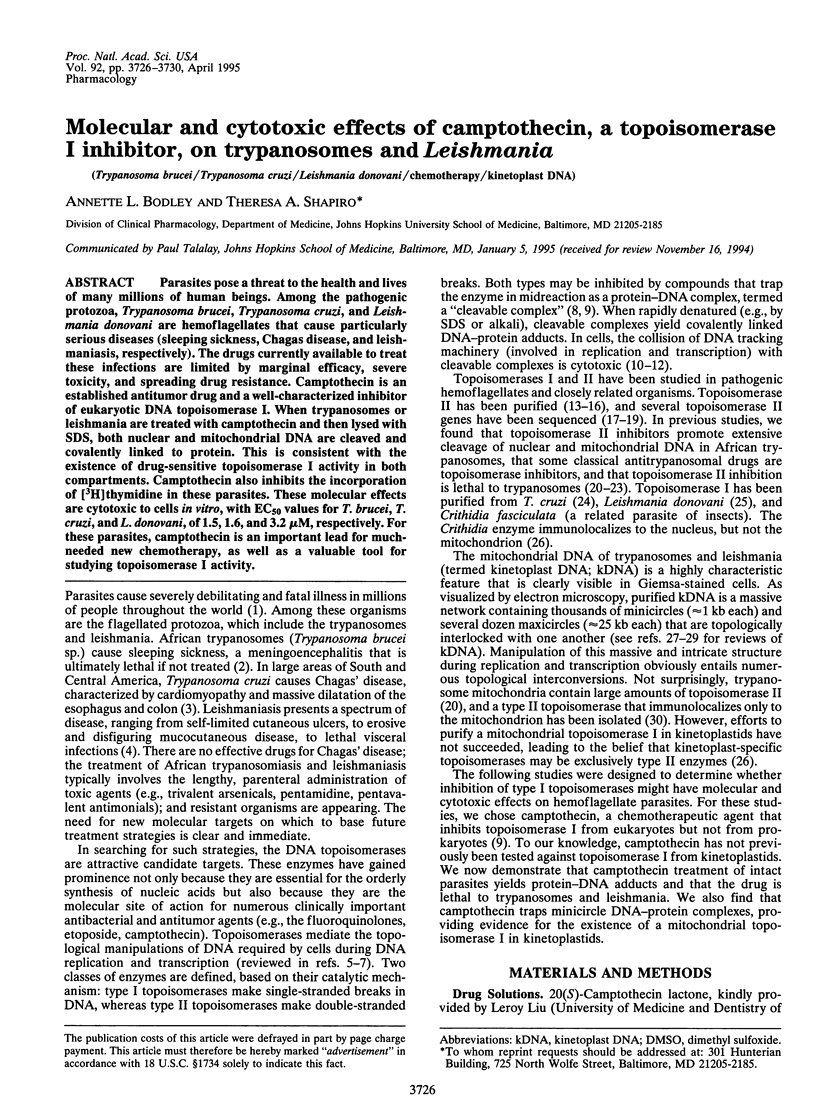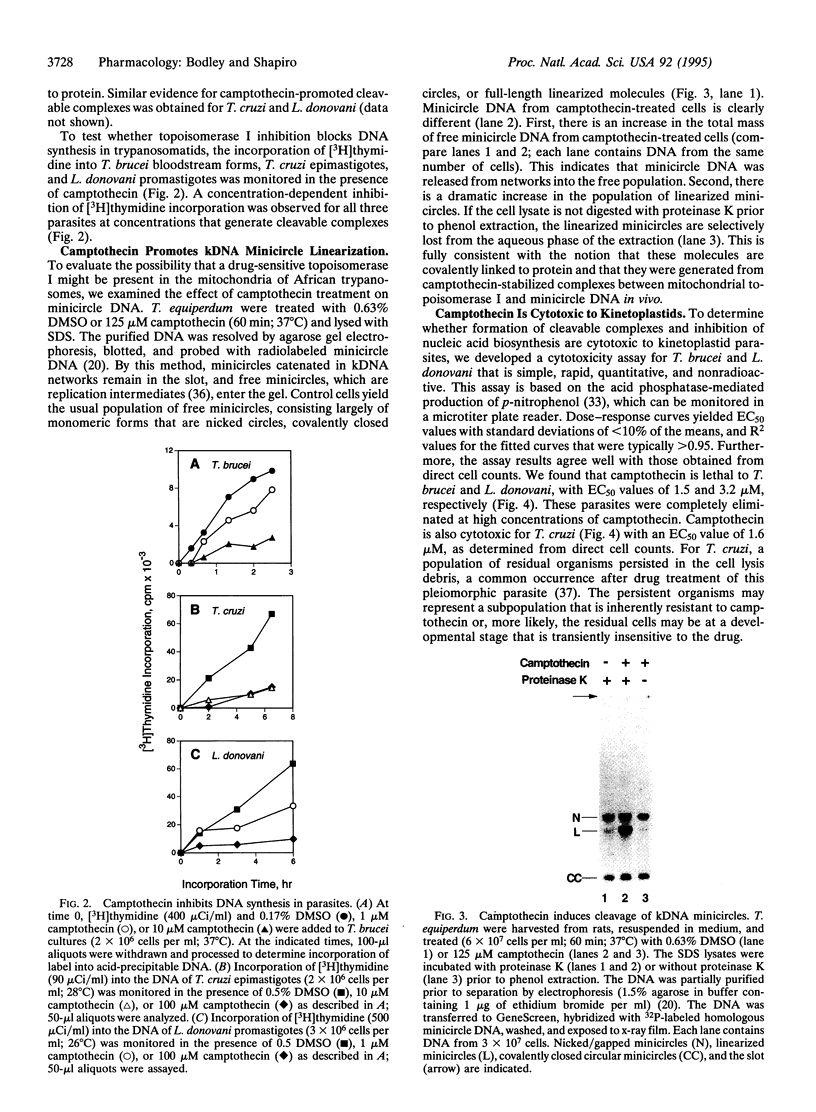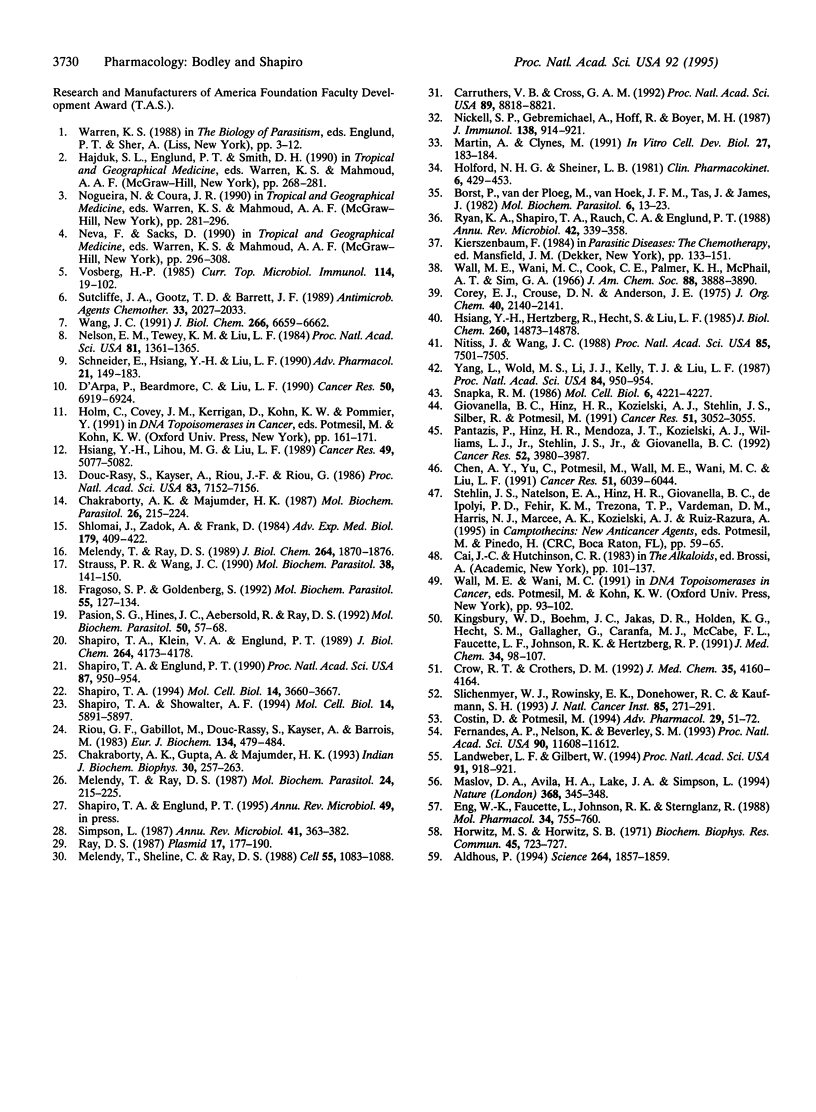Abstract
Parasites pose a threat to the health and lives of many millions of human beings. Among the pathogenic protozoa, Trypanosoma brucei, Trypanosoma cruzi, and Leishmania donovani are hemoflagellates that cause particularly serious diseases (sleeping sickness, Chagas disease, and leishmaniasis, respectively). The drugs currently available to treat these infections are limited by marginal efficacy, severe toxicity, and spreading drug resistance. Camptothecin is an established antitumor drug and a well-characterized inhibitor of eukaryotic DNA topoisomerase I. When trypanosomes or leishmania are treated with camptothecin and then lysed with SDS, both nuclear and mitochondrial DNA are cleaved and covalently linked to protein. This is consistent with the existence of drug-sensitive topoisomerase I activity in both compartments. Camptothecin also inhibits the incorporation of [3H]thymidine in these parasites. These molecular effects are cytotoxic to cells in vitro, with EC50 values for T. brucei, T. cruzi, and L. donovani, of 1.5, 1.6, and 3.2 microM, respectively. For these parasites, camptothecin is an important lead for much-needed new chemotherapy, as well as a valuable tool for studying topoisomerase I activity.
Full text
PDF




Images in this article
Selected References
These references are in PubMed. This may not be the complete list of references from this article.
- Aldhous P. Fighting parasites on a shoestring. Science. 1994 Jun 24;264(5167):1857–1859. doi: 10.1126/science.8009209. [DOI] [PubMed] [Google Scholar]
- Borst P., van der Ploeg M., van Hoek J. F., Tas J., James J. On the DNA content and ploidy of trypanosomes. Mol Biochem Parasitol. 1982 Jul;6(1):13–23. doi: 10.1016/0166-6851(82)90049-4. [DOI] [PubMed] [Google Scholar]
- Carruthers V. B., Cross G. A. High-efficiency clonal growth of bloodstream- and insect-form Trypanosoma brucei on agarose plates. Proc Natl Acad Sci U S A. 1992 Sep 15;89(18):8818–8821. doi: 10.1073/pnas.89.18.8818. [DOI] [PMC free article] [PubMed] [Google Scholar]
- Chakraborty A. K., Gupta A., Majumder H. K. A type 1 DNA topoisomerase from the kinetoplast hemoflagellate Leishmania donovani. Indian J Biochem Biophys. 1993 Oct;30(5):257–263. [PubMed] [Google Scholar]
- Chakraborty A. K., Majumder H. K. Decatenation of kinetoplast DNA by an ATP-dependent DNA topoisomerase from the kinetoplast hemoflagellate Leishmania donovani. Mol Biochem Parasitol. 1987 Dec;26(3):215–224. doi: 10.1016/0166-6851(87)90074-0. [DOI] [PubMed] [Google Scholar]
- Chen A. Y., Yu C., Potmesil M., Wall M. E., Wani M. C., Liu L. F. Camptothecin overcomes MDR1-mediated resistance in human KB carcinoma cells. Cancer Res. 1991 Nov 15;51(22):6039–6044. [PubMed] [Google Scholar]
- Corey E. J., Crouse D. N., Anderson J. E. Letter: A total synthesis of natural 20(S)-camptothecin. J Org Chem. 1975 Jul 11;40(14):2140–2141. doi: 10.1021/jo00902a034. [DOI] [PubMed] [Google Scholar]
- Costin D., Potmesil M. Preclinical and clinical development of camptothecins. Adv Pharmacol. 1994;29B:51–72. doi: 10.1016/s1054-3589(08)61131-x. [DOI] [PubMed] [Google Scholar]
- Crow R. T., Crothers D. M. Structural modifications of camptothecin and effects on topoisomerase I inhibition. J Med Chem. 1992 Oct 30;35(22):4160–4164. doi: 10.1021/jm00100a022. [DOI] [PubMed] [Google Scholar]
- D'Arpa P., Beardmore C., Liu L. F. Involvement of nucleic acid synthesis in cell killing mechanisms of topoisomerase poisons. Cancer Res. 1990 Nov 1;50(21):6919–6924. [PubMed] [Google Scholar]
- Douc-Rasy S., Kayser A., Riou J. F., Riou G. ATP-independent type II topoisomerase from trypanosomes. Proc Natl Acad Sci U S A. 1986 Oct;83(19):7152–7156. doi: 10.1073/pnas.83.19.7152. [DOI] [PMC free article] [PubMed] [Google Scholar]
- Eng W. K., Faucette L., Johnson R. K., Sternglanz R. Evidence that DNA topoisomerase I is necessary for the cytotoxic effects of camptothecin. Mol Pharmacol. 1988 Dec;34(6):755–760. [PubMed] [Google Scholar]
- Fernandes A. P., Nelson K., Beverley S. M. Evolution of nuclear ribosomal RNAs in kinetoplastid protozoa: perspectives on the age and origins of parasitism. Proc Natl Acad Sci U S A. 1993 Dec 15;90(24):11608–11612. doi: 10.1073/pnas.90.24.11608. [DOI] [PMC free article] [PubMed] [Google Scholar]
- Fragoso S. P., Goldenberg S. Cloning and characterization of the gene encoding Trypanosoma cruzi DNA topoisomerase II. Mol Biochem Parasitol. 1992 Oct;55(1-2):127–134. doi: 10.1016/0166-6851(92)90133-5. [DOI] [PubMed] [Google Scholar]
- Giovanella B. C., Hinz H. R., Kozielski A. J., Stehlin J. S., Jr, Silber R., Potmesil M. Complete growth inhibition of human cancer xenografts in nude mice by treatment with 20-(S)-camptothecin. Cancer Res. 1991 Jun 1;51(11):3052–3055. [PubMed] [Google Scholar]
- Holford N. H., Sheiner L. B. Understanding the dose-effect relationship: clinical application of pharmacokinetic-pharmacodynamic models. Clin Pharmacokinet. 1981 Nov-Dec;6(6):429–453. doi: 10.2165/00003088-198106060-00002. [DOI] [PubMed] [Google Scholar]
- Horwitz M. S., Horwitz S. B. Intracellular degradation of HeLa and adenovirus type 2 DNA induced by camptothecin. Biochem Biophys Res Commun. 1971 Nov 5;45(3):723–727. doi: 10.1016/0006-291x(71)90476-1. [DOI] [PubMed] [Google Scholar]
- Hsiang Y. H., Hertzberg R., Hecht S., Liu L. F. Camptothecin induces protein-linked DNA breaks via mammalian DNA topoisomerase I. J Biol Chem. 1985 Nov 25;260(27):14873–14878. [PubMed] [Google Scholar]
- Hsiang Y. H., Lihou M. G., Liu L. F. Arrest of replication forks by drug-stabilized topoisomerase I-DNA cleavable complexes as a mechanism of cell killing by camptothecin. Cancer Res. 1989 Sep 15;49(18):5077–5082. [PubMed] [Google Scholar]
- Kingsbury W. D., Boehm J. C., Jakas D. R., Holden K. G., Hecht S. M., Gallagher G., Caranfa M. J., McCabe F. L., Faucette L. F., Johnson R. K. Synthesis of water-soluble (aminoalkyl)camptothecin analogues: inhibition of topoisomerase I and antitumor activity. J Med Chem. 1991 Jan;34(1):98–107. doi: 10.1021/jm00105a017. [DOI] [PubMed] [Google Scholar]
- Landweber L. F., Gilbert W. Phylogenetic analysis of RNA editing: a primitive genetic phenomenon. Proc Natl Acad Sci U S A. 1994 Feb 1;91(3):918–921. doi: 10.1073/pnas.91.3.918. [DOI] [PMC free article] [PubMed] [Google Scholar]
- Martin A., Clynes M. Acid phosphatase: endpoint for in vitro toxicity tests. In Vitro Cell Dev Biol. 1991 Mar;27A(3 Pt 1):183–184. doi: 10.1007/BF02630912. [DOI] [PubMed] [Google Scholar]
- Maslov D. A., Avila H. A., Lake J. A., Simpson L. Evolution of RNA editing in kinetoplastid protozoa. Nature. 1994 Mar 24;368(6469):345–348. doi: 10.1038/368345a0. [DOI] [PubMed] [Google Scholar]
- Melendy T., Ray D. S. Novobiocin affinity purification of a mitochondrial type II topoisomerase from the trypanosomatid Crithidia fasciculata. J Biol Chem. 1989 Jan 25;264(3):1870–1876. [PubMed] [Google Scholar]
- Melendy T., Ray D. S. Purification and nuclear localization of a type I topoisomerase from Crithidia fasciculata. Mol Biochem Parasitol. 1987 Jun;24(2):215–225. doi: 10.1016/0166-6851(87)90108-3. [DOI] [PubMed] [Google Scholar]
- Melendy T., Sheline C., Ray D. S. Localization of a type II DNA topoisomerase to two sites at the periphery of the kinetoplast DNA of Crithidia fasciculata. Cell. 1988 Dec 23;55(6):1083–1088. doi: 10.1016/0092-8674(88)90252-8. [DOI] [PubMed] [Google Scholar]
- Nelson E. M., Tewey K. M., Liu L. F. Mechanism of antitumor drug action: poisoning of mammalian DNA topoisomerase II on DNA by 4'-(9-acridinylamino)-methanesulfon-m-anisidide. Proc Natl Acad Sci U S A. 1984 Mar;81(5):1361–1365. doi: 10.1073/pnas.81.5.1361. [DOI] [PMC free article] [PubMed] [Google Scholar]
- Nickell S. P., Gebremichael A., Hoff R., Boyer M. H. Isolation and functional characterization of murine T cell lines and clones specific for the protozoan parasite Trypanosoma cruzi. J Immunol. 1987 Feb 1;138(3):914–921. [PubMed] [Google Scholar]
- Nitiss J., Wang J. C. DNA topoisomerase-targeting antitumor drugs can be studied in yeast. Proc Natl Acad Sci U S A. 1988 Oct;85(20):7501–7505. doi: 10.1073/pnas.85.20.7501. [DOI] [PMC free article] [PubMed] [Google Scholar]
- Pantazis P., Hinz H. R., Mendoza J. T., Kozielski A. J., Williams L. J., Jr, Stehlin J. S., Jr, Giovanella B. C. Complete inhibition of growth followed by death of human malignant melanoma cells in vitro and regression of human melanoma xenografts in immunodeficient mice induced by camptothecins. Cancer Res. 1992 Jul 15;52(14):3980–3987. [PubMed] [Google Scholar]
- Pasion S. G., Hines J. C., Aebersold R., Ray D. S. Molecular cloning and expression of the gene encoding the kinetoplast-associated type II DNA topoisomerase of Crithidia fasciculata. Mol Biochem Parasitol. 1992 Jan;50(1):57–67. doi: 10.1016/0166-6851(92)90244-e. [DOI] [PubMed] [Google Scholar]
- Ray D. S. Kinetoplast DNA minicircles: high-copy-number mitochondrial plasmids. Plasmid. 1987 May;17(3):177–190. doi: 10.1016/0147-619x(87)90026-6. [DOI] [PubMed] [Google Scholar]
- Riou G. F., Gabillot M., Douc-Rasy S., Kayser A., Barrois M. A type I DNA topoisomerase from Trypanosoma cruzi. Eur J Biochem. 1983 Aug 15;134(3):479–484. doi: 10.1111/j.1432-1033.1983.tb07592.x. [DOI] [PubMed] [Google Scholar]
- Ryan K. A., Shapiro T. A., Rauch C. A., Englund P. T. Replication of kinetoplast DNA in trypanosomes. Annu Rev Microbiol. 1988;42:339–358. doi: 10.1146/annurev.mi.42.100188.002011. [DOI] [PubMed] [Google Scholar]
- Schneider E., Hsiang Y. H., Liu L. F. DNA topoisomerases as anticancer drug targets. Adv Pharmacol. 1990;21:149–183. doi: 10.1016/s1054-3589(08)60342-7. [DOI] [PubMed] [Google Scholar]
- Shapiro T. A., Englund P. T. Selective cleavage of kinetoplast DNA minicircles promoted by antitrypanosomal drugs. Proc Natl Acad Sci U S A. 1990 Feb;87(3):950–954. doi: 10.1073/pnas.87.3.950. [DOI] [PMC free article] [PubMed] [Google Scholar]
- Shapiro T. A., Klein V. A., Englund P. T. Drug-promoted cleavage of kinetoplast DNA minicircles. Evidence for type II topoisomerase activity in trypanosome mitochondria. J Biol Chem. 1989 Mar 5;264(7):4173–4178. [PubMed] [Google Scholar]
- Shapiro T. A. Mitochondrial topoisomerase II activity is essential for kinetoplast DNA minicircle segregation. Mol Cell Biol. 1994 Jun;14(6):3660–3667. doi: 10.1128/mcb.14.6.3660. [DOI] [PMC free article] [PubMed] [Google Scholar]
- Shapiro T. A., Showalter A. F. In vivo inhibition of trypanosome mitochondrial topoisomerase II: effects on kinetoplast DNA maxicircles. Mol Cell Biol. 1994 Sep;14(9):5891–5897. doi: 10.1128/mcb.14.9.5891. [DOI] [PMC free article] [PubMed] [Google Scholar]
- Shlomai J., Zadok A., Frank D. A unique ATP-dependent DNA topoisomerase from trypanosomatids. Adv Exp Med Biol. 1984;179:409–422. doi: 10.1007/978-1-4684-8730-5_42. [DOI] [PubMed] [Google Scholar]
- Simpson L. The mitochondrial genome of kinetoplastid protozoa: genomic organization, transcription, replication, and evolution. Annu Rev Microbiol. 1987;41:363–382. doi: 10.1146/annurev.mi.41.100187.002051. [DOI] [PubMed] [Google Scholar]
- Slichenmyer W. J., Rowinsky E. K., Donehower R. C., Kaufmann S. H. The current status of camptothecin analogues as antitumor agents. J Natl Cancer Inst. 1993 Feb 17;85(4):271–291. doi: 10.1093/jnci/85.4.271. [DOI] [PubMed] [Google Scholar]
- Snapka R. M. Topoisomerase inhibitors can selectively interfere with different stages of simian virus 40 DNA replication. Mol Cell Biol. 1986 Dec;6(12):4221–4227. doi: 10.1128/mcb.6.12.4221. [DOI] [PMC free article] [PubMed] [Google Scholar]
- Strauss P. R., Wang J. C. The TOP2 gene of Trypanosoma brucei: a single-copy gene that shares extensive homology with other TOP2 genes encoding eukaryotic DNA topoisomerase II. Mol Biochem Parasitol. 1990 Jan 1;38(1):141–150. doi: 10.1016/0166-6851(90)90214-7. [DOI] [PubMed] [Google Scholar]
- Sutcliffe J. A., Gootz T. D., Barrett J. F. Biochemical characteristics and physiological significance of major DNA topoisomerases. Antimicrob Agents Chemother. 1989 Dec;33(12):2027–2033. doi: 10.1128/aac.33.12.2027. [DOI] [PMC free article] [PubMed] [Google Scholar]
- Vosberg H. P. DNA topoisomerases: enzymes that control DNA conformation. Curr Top Microbiol Immunol. 1985;114:19–102. doi: 10.1007/978-3-642-70227-3_2. [DOI] [PubMed] [Google Scholar]
- Wang J. C. DNA topoisomerases: why so many? J Biol Chem. 1991 Apr 15;266(11):6659–6662. [PubMed] [Google Scholar]
- Yang L., Wold M. S., Li J. J., Kelly T. J., Liu L. F. Roles of DNA topoisomerases in simian virus 40 DNA replication in vitro. Proc Natl Acad Sci U S A. 1987 Feb;84(4):950–954. doi: 10.1073/pnas.84.4.950. [DOI] [PMC free article] [PubMed] [Google Scholar]



